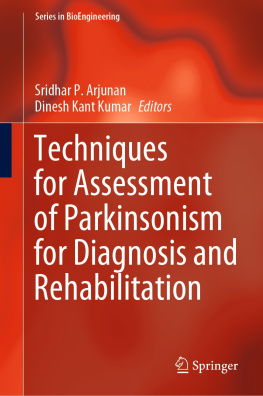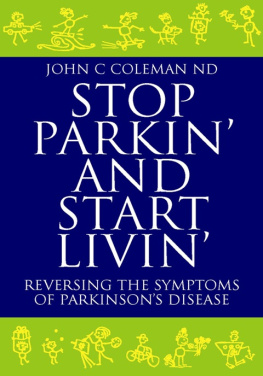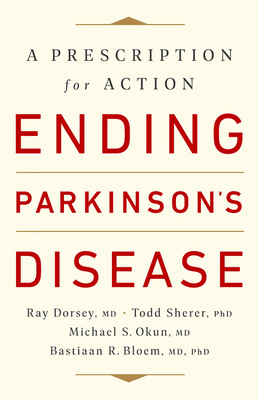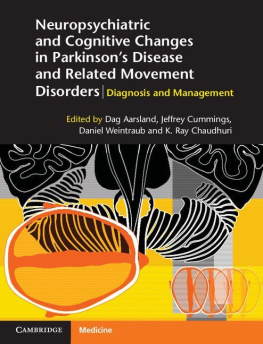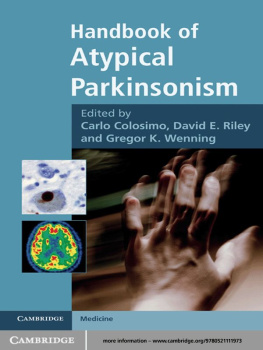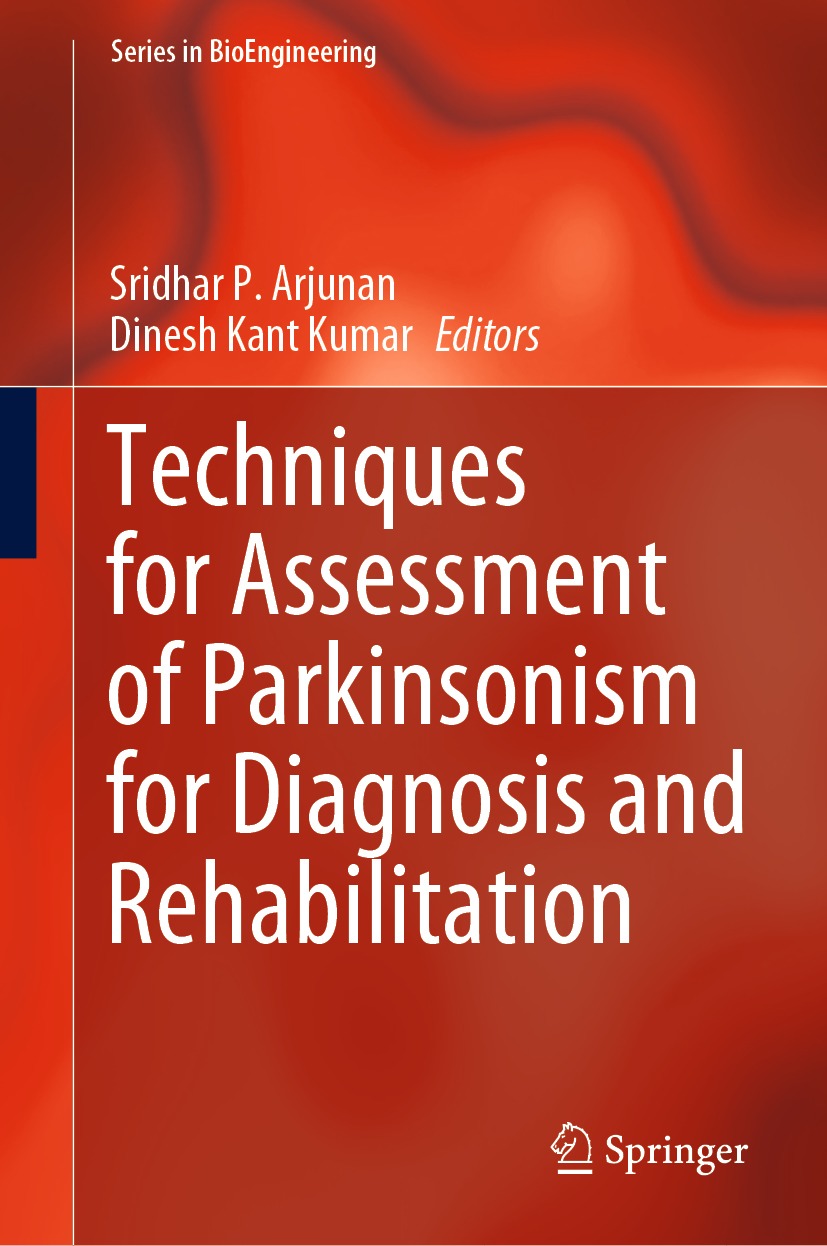Series in BioEngineering
The Series in Bioengineering serves as an information source for a professional audience in science and technology as well as for advanced students. It covers all applications of the physical sciences and technology to medicine and the life sciences. Its scope ranges from bioengineering, biomedical and clinical engineering to biophysics, biomechanics, biomaterials, and bioinformatics.
Indexed by WTI Frankfurt eG, zbMATH.
More information about this series at http://www.springer.com/series/10358
Editors
Sridhar P. Arjunan and Dinesh Kant Kumar
Techniques for Assessment of Parkinsonism for Diagnosis and Rehabilitation
1st ed. 2022

Logo of the publisher
Editors
Sridhar P. Arjunan
Department of Electronics and Instrumentation Engineering, SRM Institute of Science and Technology, Kattankulathur, Tamil Nadu, India
Dinesh Kant Kumar
Biosignals lab, School of Engineering, RMIT University, Melbourne, VIC, Australia
ISSN 2196-8861 e-ISSN 2196-887X
Series in BioEngineering
ISBN 978-981-16-3055-2 e-ISBN 978-981-16-3056-9
https://doi.org/10.1007/978-981-16-3056-9
The Editor(s) (if applicable) and The Author(s), under exclusive license to Springer Nature Singapore Pte Ltd. 2022
This work is subject to copyright. All rights are solely and exclusively licensed by the Publisher, whether the whole or part of the material is concerned, specifically the rights of translation, reprinting, reuse of illustrations, recitation, broadcasting, reproduction on microfilms or in any other physical way, and transmission or information storage and retrieval, electronic adaptation, computer software, or by similar or dissimilar methodology now known or hereafter developed.
The use of general descriptive names, registered names, trademarks, service marks, etc. in this publication does not imply, even in the absence of a specific statement, that such names are exempt from the relevant protective laws and regulations and therefore free for general use.
The publisher, the authors and the editors are safe to assume that the advice and information in this book are believed to be true and accurate at the date of publication. Neither the publisher nor the authors or the editors give a warranty, expressed or implied, with respect to the material contained herein or for any errors or omissions that may have been made. The publisher remains neutral with regard to jurisdictional claims in published maps and institutional affiliations.
This Springer imprint is published by the registered company Springer Nature Singapore Pte Ltd.
The registered company address is: 152 Beach Road, #21-01/04 Gateway East, Singapore 189721, Singapore
Preface
Parkinsons disease is a disorder of the central nervous system. It is the second most common neurodegenerative disorder, with over 0.5% of the population having this disease. The median age of people first diagnosed with Parkinsons disease is around 65 years, and thus its prevalence is expected to increase with an aging population. With no blood tests, or easily available imaging tests, the presence of two or more motor symptoms of tremor, bradykinesia, rigidity, or postural impairment are considered as the basis for the diagnosis of the disease. Dopamine transporter scan can be performed using Positron Emission Tomography (PET) as confirmatory evidence, which however are yet only available in few places.
The standard tools for the diagnosis and monitoring of PD uses Movement Disorder Society Unified Parkinsons Disease Rating Scale Part III (MDS-UPDRS-III). However, this requires clinical observations and thus has the limitations of clinician bias and potential of missing some of the early symptoms. This results in a loss of sensitivity and specificity. Early stage diagnostics can be missed, and it is also difficult to monitor the effectiveness of treatment and disease progression.
Parkinsons disease is associated with the loss of habitual activity. Walking, speaking, and writing are three activities of people that are habitual to healthy people and have been found to be impaired among the people with Parkinsons disease. PD patients often have dysarthria, or slurring in voice, and display micrographia or handwriting becoming small in the early stages of their disease. These can occur up to 5 years before the tremor. Thus, the use of gait analysis, handwriting analysis, and speech or voice analysis has been proposed for early diagnosis of the disease. The number of researchers have proposed computer-based techniques that can be used to quantify these symptoms and provide objective measures for the clinicians. This field is fast developing and there is an urgent need for technical solutions to get accurate and objective measures of the symptoms so that the disease can be identified in the early stages, and its progression can be monitored.
Scheme for Promotion of Academic and Research Collaboration (SPARC) with the aim of supporting Indian researchers to solve global challenges, has provided a platform to collaborate with international experts for developing this book. The aim of this book is to provide a review along with expert opinions on this very needed issue. We, the authors have assembled this book with the aim of sharing with you the current state of the art and identified potential research directions that will be useful. We are a team of clinicians, engineers, and scientists, and have provided the width of background and expertise through the book and attempted to provide you with the information regarding a large width of technologies. We do hope that you will find this useful, and we will soon have the methods to help reduce the burden of this disease in our society.
Sridhar P. Arjunan
Dinesh Kant Kumar
Kattankulathur, India Melbourne, Australia
Abbreviations
-Syn
-Synuclein
AADC
L-Amino acid decarboxylase
AD
Autosomal dominant
ApoE4Apolipoprotein E4
AR
Autosomal recessive
BDNFBrain-derived neurotrophic factor
CBD
Cortico-basal degeneration
COMTCatechol-O-methyltransferase
COMTI
Catechol-O-methyltransferase inhibitors
DaT scan
Dopamine Transporter single-photon emission computed tomography
DBS
Deep brain stimulation
DLB
Dementia with Lewy bodies
ET
Essential tremor
FDA
Food and drug administration
GBAGlucocerebrosidase
GPi
Globus pallidus pars interna
ICD
Impulse-control disorders
MAOIs
Monoamine oxidase inhibitors
MAPTMicrotubule associated protein tau
MCI
Mild cognitive impairment
MPTP
1-Methyl-4-phenyl-1,2,5,6-tetrahydropyridine
MRI
Magnetic resonance imaging
MSA
Multiple systems atrophy
NMDA
N-Methyl-D-aspartate receptor
PD
Parkinsons Disease
PDD
Parkinsons disease dementia
PET
Positron emission tomography
PSP
Progressive supranuclear palsy
PSP-P
PSP-Parkinsonism
RBD
Rapid eye movement (REM) sleep behaviour disorder
REM
Rapid eye movement
SCA
Spinocerebellar Ataxia
SN
Substantia nigra
SSRI
Selective serotonin reuptake inhibitor

